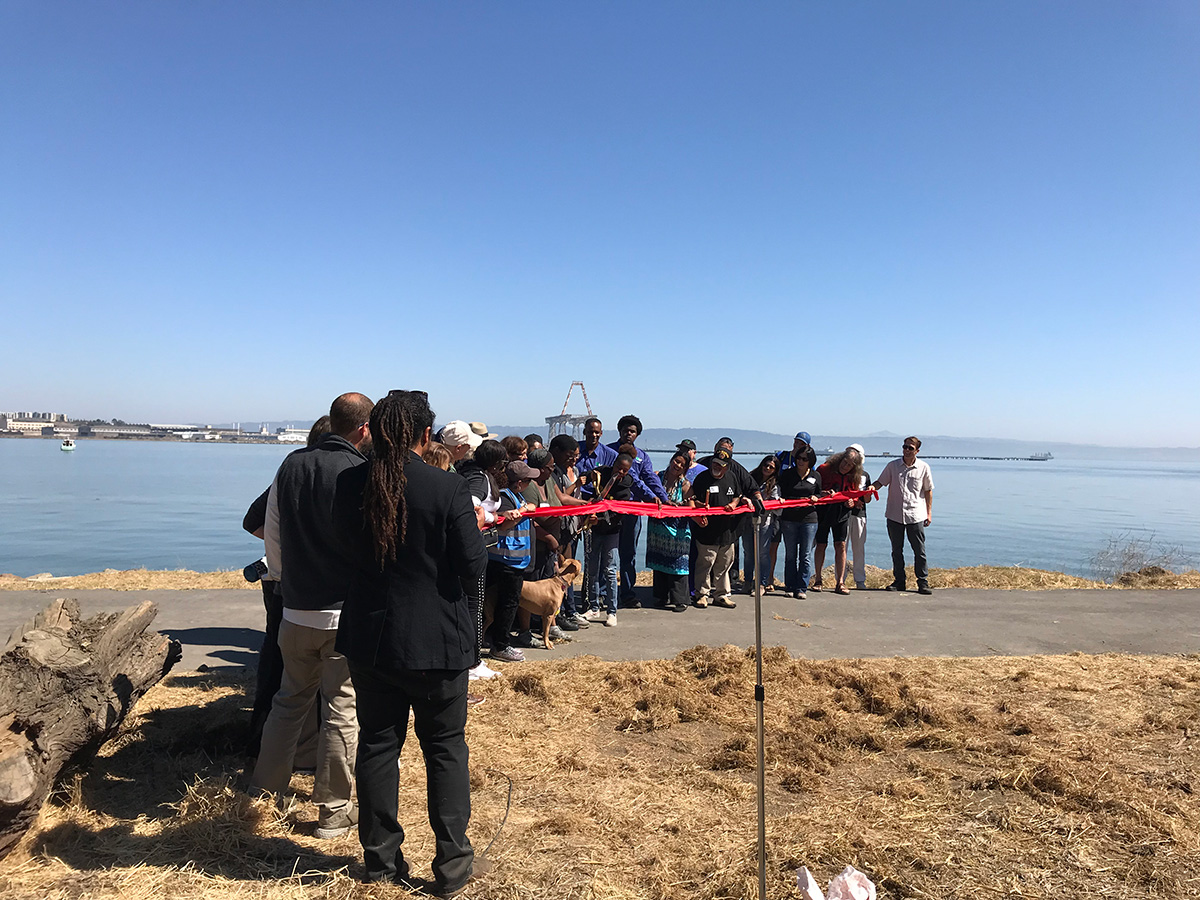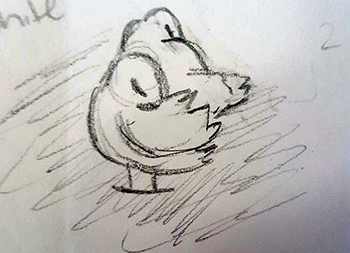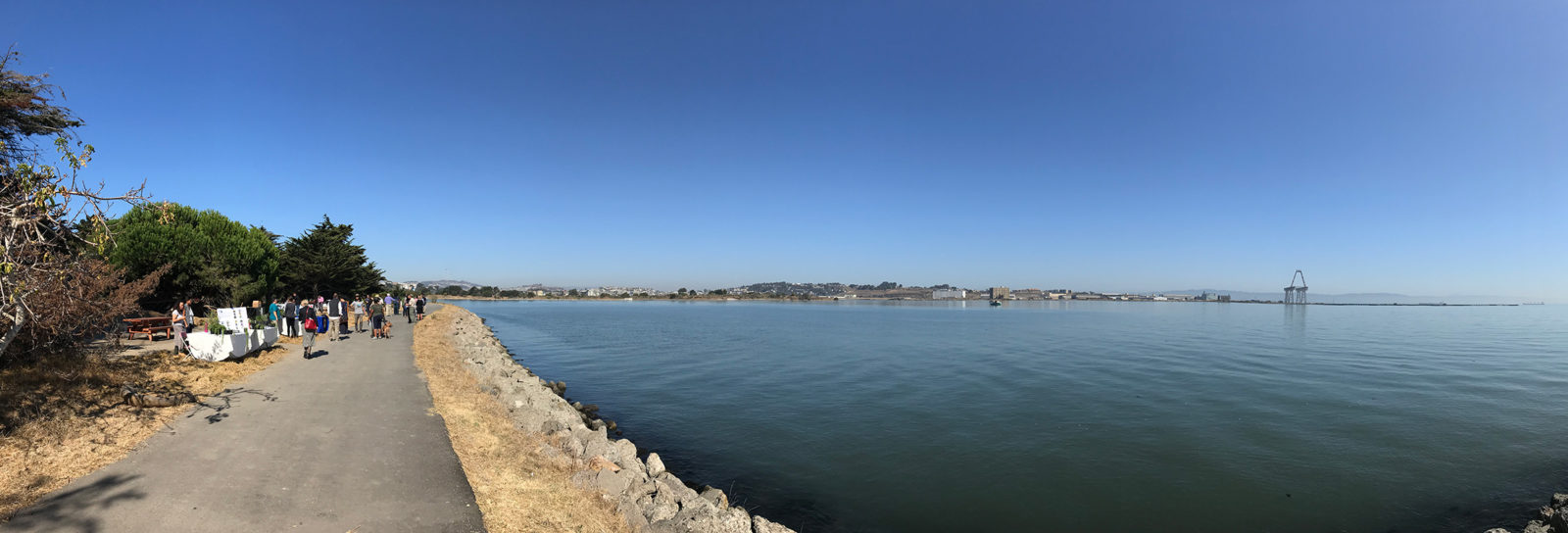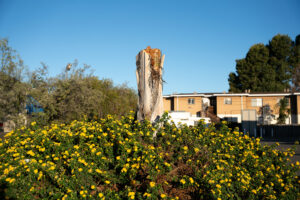Six campsites opened at Candlestick Point State Recreation Area (CPSRA) last fall, offering only the second public campsites within San Francisco city limits and, in many ways, a contrast with the city’s inaugural campground in the Presidio. The Candlestick Sunrise Point campsites sit right on the Bay, the opposite corner of the city from the Presidio Rob Hill sites that overlook the ocean. The Presidio rubs shoulders with some of the most affluent neighborhoods in the city, whereas Candlestick is located in a historically low-income neighborhood, comprising people of color and immigrants, and surrounded by heavy industry.
What does it mean for this low-income neighborhood that has faced severe environmental injustice to have campsites installed in a newly restored 3-acre peninsula with a view of San Bruno Mountain to the southwest and a view of the contaminated naval shipyard to the north? At first glance, contradictions seem to collide at Sunrise Point. On closer examination, maybe these contradictions are a sign of changing times, changing relationships to nature, and changing views of what a city is, and what we want it to be.
CPSRA, established in 1977, is California’s first urban state park. The land was returned to the public and added to the State Parks system after years of community organizing and more than 300 public meetings. By the beginning of the 20th century dumping from industrial and household waste had destroyed much of the original rich marshland, and during World War II the area was filled. The vision for a restored shoreline was spearheaded by elders in the neighborhood who remembered the days when they enjoyed the natural beauty and bounty of the marshy shoreline. Today this vision is only about 50 percent complete. While the park is seeing increased interest and investment from developers like Five Point and Build Inc as well as San Francisco redevelopment agencies, the neighborhood the park sits in houses 80 percent of San Francisco’s polluting industries and ties with Richmond and West Oakland for the highest level of airborne particulate matter in the Bay Area. The vision for ecologically restored, clean open space in this historically underserved community existed when the park was first formed, and the campsites at Sunrise Point are a milestone, representing new resources for the neighborhood and pointing towards new ways of relating to nature in the urban landscape.
Remember, they are an exotic species in the Western United States, and are rapidly increasing their geographic range and range of habitats. Are they outcompeting or excluding native species in the process? How would we know? We have done almost nothing to monitor changes in the assemblage of mushroom species in areas before and and after the incursion of death caps.
Further Reading
Pringle et al, “The ectomycorrhizal fungus Amanita phalloides was introduced and is expanding its range on the west coast of North America,” Molecular Biology 2009
Lockhart et al, “Simultaneous emergence of multidrug-resistant Candida auris on 3 continents confirmed by whole-genome sequencing and epidemiological analyses,” Clinical Infectious Diseases 2017
Battalani et al, “Aflatoxin B1 contamination in maize in Europe increases due to climate change,” Scientific Reports 2016
How to Visit
Campsites are available through reservecalifornia.com.
LEJ hosts community campouts, kayaking and day trips at Candlestick through its new Eco-Adventure program. Contact Bridget Llanes, Community Programs Manager for more information at bridget.llanes@lejyouth.org.
The campsites also come at a time of major change for the neighborhood. Candlestick is in the midst of a 700-acre shoreline redevelopment, the largest San Francisco development effort since the 1906 earthquake, promising to bring roughly 25,000 new residents to the area over the next several years, increasing property values and rents, and threatening the continued displacement of many long-term residents. State Parks took the redevelopment of the area, the closure of Candlestick Stadium, and projected sea level rise as an opportunity to revisit its incomplete park plans and in the early 2000s held a series of community meetings to update the parks general plan. The campsites, nestled within restored habitat at Sunrise Point, were born out of this process.

In 2013, my organization Literacy for Environmental Justice (LEJ), a non-profit partner to State Parks that has worked for 20 years in the neighborhood on the burden of pollution, access to open space, local ecological literacy and youth development, joined in partnership with State Parks to fund and install the campsites.
To prepare, LEJ began working with local youth and nearby residents to propagate about 20,000 locally collected native species at its Candlestick Point Native Plant Nursery, for planting on the peninsula. Five years later, and after restoration of grassland and coastal scrub habitats, a ribbon-cutting ceremony was held at the Sunrise Point Campsites last October. The campsites were blessed with song and prayer by the Ohlone Tribal council, descendants of the first residents to be displaced from what we now call Bayview/Hunters Point (BVHP). The southeast San Francisco shoreline is the site of 16 former Ohlone villages and shell mounds, which makes it the area of highest historical Native density in San Francisco. Although not a federally recognized tribe, there are family lineages living in the area to this day who can trace their ancestry back to the time of Spanish arrival in the Bay Area and continue to assert their existence and rights to the land.
“Giving the Ohlone space in order to pray and listen and reconnect and think forward; having a place to practice and strengthen and find joy and affirm each other is a huge gift,” says Neal Maclean, who co-directs a non-profit, ‘Support for Intertribal Gatherings,’ that brings Ohlone, Miwok and Pomo tribal groups to San Francisco.
Since the campsites opened in October 2018, LEJ has hosted four community campouts, bringing residents of BVHP a nature experience that many have never had before. Demarion Jones, 16, and an intern with LEJ’s Eco-Apprentice program, tells of wandering Sunrise Point with his friends, playing tricks on each other, fishing off the pier until the wee hours of the morning, and the experience of quiet solitude, staring out into the dark and letting his mind wander. The freedom and opportunity for inner reflection he describes are rare for teenagers growing up in the city and in the tech-fueled modern world. Jones told me he marvels over how the Bay waters rise and fall, like a “heartbeat” bringing the water in and out. I imagine the old timers who advocated for restored parkland at Candlestick, hoped their great-grandchildren would have the opportunity for just this sort of revelation.
Lyslynn LaCoste, the executive director of BMAGIC, a non-profit organization that acts as a neighborhood convener for organizations working to keep youth out of the criminal justice and foster care systems, says she sees the link between access to open space and community health and “how park safety and engagement reflects safety and engagement residents feel in their community.”
In 2012, LaCoste began to work with community activists, Parks 94124 — a grassroots friends-of-parks group — LEJ, and other neighborhood organizations on increasing use and access to existing open space in the Bayview. She envisioned revitalizing parks as a way to bring community together, build resiliency and interconnectedness, and with this, a sense of safety and pride in place, while offering opportunities for exercise, and healthy play for children that is critical for their development.
Dr. Nooshin Razani, a pediatrician at UCSF Benioff Children’s Hospital in Oakland who has spearheaded programs to get low-income children and families into nature, says there is “plenty of research that shows that there are normal childhood milestones that are aided by access to nature and access to the outdoors, (from) stress release, physical activity and social connection, (to the development of) social emotional skills, as well as motor skills.”
After joining one of LEJ’s community campouts LaCoste reflected on the joys — the evening outdoors was comfortable, with easily accessible bathrooms, large campsites, picnic tables, grills, and water spigots. She said she was surprised by the amount of nature nearby, from the thug ground squirrels (they are ubiquitous and will steal your food!) to the jack rabbits, shorebirds, song birds (CPSRA sees over 120 bird species throughout the year), lizards, snakes and the recently arrived trickster, coyote.
But barriers remain to be overcome before everyone can experience the peace and quiet of this urban park. Due to security issues both real and imagined, there is no overnight parking at the park, so these sites are hike-in, bike-in, boat-in only. For the beginner camper, LaCoste pointed out, this can pose a serious challenge. On the other hand, in an era of climate change, in a neighborhood with the worst air quality in the city and with traffic an ever-growing problem, moving away from car dependency is forward thinking. Prohibiting cars and encouraging biking and boating (the site is on the Bay Water Trail) could be seen as a progressive step in the right direction. The park has yet to install bike racks at the sites and the closest bus line is a 13-minute walk to the entrance of the park — and from there it’s another quarter mile walk to the campsites. Despite these challenges, a car-free Sunrise Point contributes to the feeling of being away from the stress of urban life, making room for connection to nature to occur.
Remember, they are an exotic species in the Western United States, and are rapidly increasing their geographic range and range of habitats. Are they outcompeting or excluding native species in the process? How would we know? We have done almost nothing to monitor changes in the assemblage of mushroom species in areas before and and after the incursion of death caps.
Further Reading
Pringle et al, “The ectomycorrhizal fungus Amanita phalloides was introduced and is expanding its range on the west coast of North America,” Molecular Biology 2009
Lockhart et al, “Simultaneous emergence of multidrug-resistant Candida auris on 3 continents confirmed by whole-genome sequencing and epidemiological analyses,” Clinical Infectious Diseases 2017
Battalani et al, “Aflatoxin B1 contamination in maize in Europe increases due to climate change,” Scientific Reports 2016
Journaling from the Candlestick Campground
Jasmine Jeffries, a 24-year-old eco-apprentice at LEJ, was one of the first campers to spend time at Sunrise Point. Each camper set a goal for the trip in July 2018; Jeffries’s was to sketch the animals she saw. Here are some of her journal entries, from the ground squirrels — “I feel like this park is famous for its squirrel gang. Once you start cooking, the squirrels pop up from random areas.” — to the variety of birds.

“My goal was to try to draw the animals or whatever inspired me. Their general shape caught my eye.” (Illustration by Jasmine Jeffries)

There were a lot of birds, “mainly during low tide around the water, eating. I saw two snowy egrets fighting in the air. I wanted to take a picture of it, but it happened so quickly.” (Illustration by Jasmine Jeffries)

“Most parks have bears, but Candlestick Park has squirrels.” (Illustration by Jasmine Jeffries)
Perceived issues of park danger are both outdated holdovers from a previous era when crime rates were higher, while also reflecting fears of strangers and fear of difference that are common among urbanites. Some community members continue to hold a negative image of Candlestick Park. Some residents, Lacoste says, “have bad memories of the park, and are worried about safety.”
In my own recent camping experience at Sunrise Point, I enjoyed peaceful quiet and solitude. By sundown, most park users had gone home. The rangers continued to patrol until about 8 p.m. and checked in on me. The familiar tension that comes with keeping up with the speed of deadlines and traffic, to-do lists and chores slowly slipped off my shoulders as the silence and darkness settled in. I felt safe. “A huge effort needs to be put into rebranding,” LaCoste says. “We need to reach out to those that have been using Candlestick for years and involve them in the rebranding process as a way to make sure it isn’t rebranded away from historical members of the community.”
A common phenomena in the creation of new open spaces, or in renewing existing spaces, is that the process is undertaken without broad representation from the neighborhood the open space is located in. This, coupled with a dominant culture that profiles and criminalizes people of color, especially in cleaner, newer, “nicer” spaces, contributes to the feeling by many long-time residents in communities facing gentrification of not-belonging in their own park. In a time of hyper-gentrification in the Bayview, the restoration of Sunrise Point and the installation of campsites could be seen by locals as evidence of coming displacement — that this space isn’t really FOR them. This perception is a real barrier to use. Any marketing effort around the park needs to come from those who use it now and have used it for years, so that the messaging stays culturally relevant to the community.
Literacy for Environmental Justice has been working with nearby residents to try to lead the vision for the park from the grassroots. LEJ and other organizations, like Kids in Parks, Bay Area Wilderness Training and BMAGIC are working with residents of BVHP, local schools, and neighborhood groups to help facilitate nature experiences at Candlestick and overcome some of the barriers around physical access to the park, access to outdoor gear, park safety, and perceptions of belonging. Working together, these groups try to build comfort with what for many residents is the brand-new experience of camping by offering free gear rentals, as well as coordinated community campouts and community trainings on how to set up camp, prepare food outdoors, leave-no-trace practices and basic team building and nature skills. As the park’s planned upgrades continue, including a non-motorized dock adjacent to the sites, continued habitat restoration and stewardship, a gathering area with a campfire, enhancements to aging bathrooms and upgrades to the fishing piers, LEJ hopes to work with the community to ensure residents are involved every step of the way.
The campsites at Sunrise point are intended to address historic inequities in access to quality, open space experiences. Razani says she envisions a city where you don’t “have to go somewhere in order to experience nature,” where nature is integrated into our urban landscape so that it is there for everyone, not just those who have money to afford to live in the prettier tree-lined neighborhoods, or those who have the time and money to get in their cars and take a trip out of the city. Creating neighborhoods that invest in the people who live in them as much as the space they inhabit, Razani says, is key to achieving equity and fighting issues of gentrification that can come with improved public spaces.
Safe, walkable, playable neighborhoods encourage outdoor time and community connection for all. Sunrise Point’s car-free campsites in the middle of a dense city in the middle of an industrial zone move us in this direction. While the market forces of development loom tall over the Candlestick landscape, government, local organizations, citizens and communities need to make sure that the profits of the developers are not held more sacred than the real people who the development effects. As we’ve seen beautification and greening can be correlated with increased values of local property, adding fuel to the many forces spurring the intense gentrification we see today, we need to make sure that ALL neighborhoods everywhere are green and beautiful. We need to build urban neighborhoods that are integrated with nature at every step, that continue to display the same kind of cultural diversity we consider healthy in nature, where families feel free from danger, and where economic inequality does not prevent access to clean, healthy, open space.





